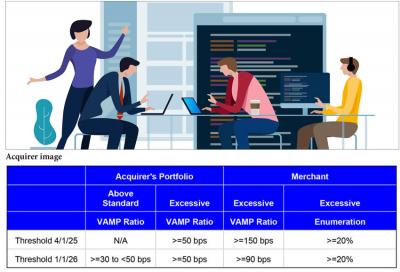The Green Sheet Online Edition
March 3, 2025 • 25:03:01
VAMP enhancements - February 2025

The Visa Acquirer Monitoring Program (VAMP) is being enhanced and reformed. Effective April 1, 2025, the Visa Dispute Monitoring Program (VDMP) and the Visa Fraud Monitoring Program (VFMP) are being consolidated into the new VAMP.
The new VAMP is intended to strengthen acquirer risk controls to enhance the safety of the Visa platform. It specifically targets card-not-present (CNP) transactions.
New criteria based on a combined ratio of CNP fraud transactions plus CNP non-fraud disputes are measured against totaled CNP settled transactions.
This is calculated for both merchants and acquirers. Enumerated transactions will also be monitored. Beginning April 1, merchants and acquirers will be entered into an advisory period which runs through June of 2025.
No fees will be assessed during this period, but acquirers should ensure they have appropriate risk controls, as enforcement actions begin in July of 2025.
Measuring the ratios
VAMP will target larger merchants and acquirers. A minimum 1,000 monthly offending transactions are necessary before VAMP requirements apply. The ratio for both the acquirer and merchant is measured as follows:
Sum of CNP fraud by post date(TC 40) + non-fraud chargebacks (TC 15 condition codes 11,12,13)
VAMP Ratio* = ----------------------------------------------------- Settled CNP Transactions (TC 05)
*RDR’s and CDRN non-fraud returns and Compelling Evidence 3.0 disputes are excluded from the numerator # of Enumerated Transactions
VAMP Enumeration Ratio = ------------------------------------ # of Enumerated Auth attempts (approvals + declines)
(See Acquirer image)
Currently, to obtain the thresholds, acquirers and merchants need to comb through their TC 40, TC 15 and TC 05 reports, but Visa is updating Visa Online with additional tools and training. These additional tools will calculate the metrics needed to determine compliance. Instead of today's non-compliance assessments, compliance will be enforced through fines.
Acquirers are given latitude as to whether to maintain the merchant within their portfolio. From the acquirer’s perspective, trailing activity will count toward their ratios. Additionally, non-disputed fraudulent transactions are less visible and often have a significant tail. Those numbers must be managed, nonetheless. RDR’s, CDRN non-fraud returns and compelling evidence 3.0 disputes will be excluded from the VAMP numerator.
Disadvantaging small acquirers
This format significantly disadvantages small acquirers and their merchants. Small acquirers do not have the CNP mega merchants to offset their portfolios. A small acquirer losing a large CNP merchant will be disproportionately impacted. Merchants working with smaller acquirers will pay the price. Think about a small acquirer who exceeds the 30 or 50 bps threshold.
All transactions from merchants who exceed the 30 bps threshold will be fined—even if the merchant’s own VAMP ratio was below the "excessive" ratio. Large acquirers will naturally have a lower CNP VAMP ratio so that same merchant, at the larger acquirer, with the exact same ratio will not be impacted.
If a merchant exceeds the specified threshold, a $10 fine will apply to each non-fraud dispute and TC 40 item. I emphasize this point, as the fine does not just apply to the offending transactions over the threshold. If the Acquirer is above standard, it will incur a $5 fine for each non-fraud dispute and TC 40 for all merchants with a VAMP ratio of >= 30 (or 50) bps. The acquirer fee jumps to $10 for excessive acquirers.
Once enforcement begins, first-time offenders within a rolling 12-month period will have a three-month grace period to remediate before fines commence.
Acquirers and their merchants should prepare for the coming changes. Though Visa is implementing an advisory period, fraud reporting significantly lags chargebacks so the tail on fraudulently posted transactions is elongated.
Acquirers and merchants need to understand and calculate these ratios now so they are prepared for the impacts and adjust accordingly. This is a new structure, and new tools should be decked out as fraud and disputes are correlated but different.
Merchants should enroll and utilize an alert service to take advantage of the ability to transform a pre-dispute to a return. Merchants should work with their Acquirer to understand their Acquirer’s VAMP Ratio. Implementing Compelling Evidence should also be considered.
Note: This article updates preliminary information provided in "Visa acquiring monitoring program," published in The Green Sheet's issue 25:01:01, www.greensheet.com/emagazine.php?article_id=7754. 
As founder of Humboldt Merchant Services, co-founder of Eureka Payments, and a former executive for such payments innovators as WePay, a division of JPMorgan Chase, Ken Musante has experience in all aspects of successful ISO building. He currently provides consulting services and expert witness testimony as founder of Napa Payments and Consulting, www.napapaymentsandconsulting.com. Contact him at kenm@napapaymentsandconsulting.com, 707-601-7656 or www.linkedin.com/in/ken-musante-us.
Whether you want to upgrade your POS offerings, find a payment gateway partner, bone up on fintech regs or PCI requirements, find an upcoming trade show, read about faster payments, or discover the latest innovations in merchant acquiring, The Green Sheet is the resource for you. Since 1983, we've helped empower and connect payments professionals, starting with the merchant level salespeople who bring tailored payment acceptance and digital commerce tools, along with a host of other business services to merchants across the globe. The Green Sheet Inc. is also a proud affiliate of Bankcard Life, a premier community that provides industry-leading training and resources for payment professionals.
Notice to readers: These are archived articles. Contact information, links and other details may be out of date. We regret any inconvenience.





